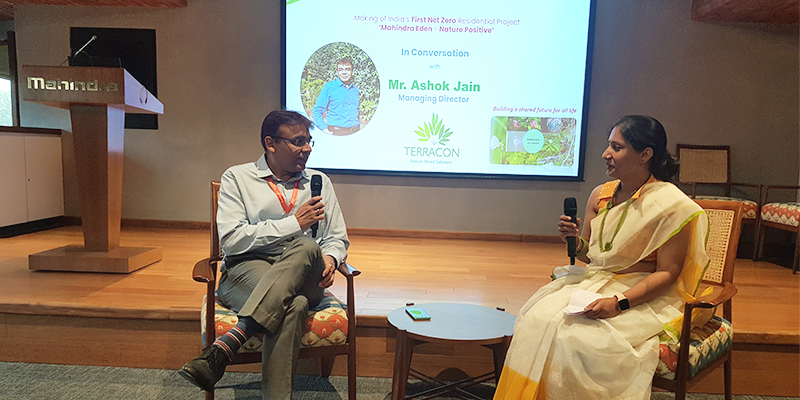
Blogs

22nd May has been proclaimed by the United Nations as the ‘International Day for Biological Diversity (IDB)’ to increase understanding and awareness of biodiversity.
Aligned with this year’s theme, ‘Building a shared future for all life’, we, at Mahindra Lifespaces celebrated the efforts put together in enhancing biodiversity in one of the recent projects based on nature-positivity. Mahindra Eden is India’s first Net-Zero Energy project launched in Bengaluru.
Mr. Arvind Subramanian, MD & CEO, Mahindra Lifespaces addressed the audience on the importance of placing nature at the center stage of development and creating a habitat where biodiversity can thrive. He also reiterated Mahindra Lifespaces’ commitment to building only Net-Zero buildings from 2030 onward.
To provide insights on the need for biodiversity conservation, and its importance in urban development, we had a detailed conversation hosted by Dr. Sunita Purushottam, Head of Sustainability, Mahindra Lifespaces, with our guest speaker for the day – Mr. Ashok Jain, the Co-Promoter and Managing Director of Terracon Ecotech Private Limited, a Nature-based Solutions Company, as well as NABET, accredited EIA Consultants based in Mumbai, which is involved in the assessment and enhancement of nature-positivity at Eden.
He has over 25 years of work experience in diverse industries such as environment, financial services, agribusiness & retail and has been professionally associated with several large corporate houses such as Tata Group, RPG Group, and Shoprite Group of South Africa, and the Australian Government. He is an ardent advocate of Nature-based Solutions and has been actively involved with several organizations in their pursuit of becoming Nature Positive by 2030.
This is what he has to say in response to the questions put forth by Dr. Sunita Purushottam –
Loss of species, the possibility of sixth mass extinction, and increased dependence of people and businesses on nature have created the need for protecting and preserving nature. Moreover, the process of decarbonization of businesses cannot be successful without addressing the issue of the loss of nature. Both must go hand in hand if we are to solve the climate change issue.
Ecosystems are naturally interrelated. A break in the natural habitat or dependence of the native species may end up disturbing their ecosystem and the benefits derived from it. Native species promote healthy ecosystems and biodiversity.
Humans have been living with Nature since time immemorial for general happiness, wellbeing, and spirituality. With growing urbanization, it is important to integrate biodiversity and other elements of Nature in the urban living spaces. The typical characteristic of the urban landscape is:
There are three ways –
Lack of symmetry, limited color options, and limited exploration by horticulturists have created this myth. There are many species of flora that provide color breaks and palette for a vibrant landscape urban. We need to research and test these species that most landscape architects and horticulturists don’t venture into. Therefore, ecological landscaping needs to be ingrained in our minds.
Species that are non-native or alien to a particular environment, and whose introduction into that environment could cause
Natural regeneration of native species could be halted, resulting in the extinction of native plants and animals, destroying biodiversity, damaging ecosystem functions, and permanently changing habitats.
The concept of being Nature-positive has been driven due to the robust biodiversity that was found in Kanakapura before the construction began.
The entire design and architecture layout was biodiversity supportive with all ecologically important habitats being retained, 80% of trees being retained or transplanted, the compensatory plantation in the ratio of 10 trees for each tree removed, and promoting native species.
While the world has been focussing and looking at the climate change issue purely from the carbon emission point of view, most have forgotten to consider the removal or sequestration of carbon from the atmosphere as a potent solution to this issue. Trees and several types of ecosystems have the potential to trap atmospheric carbon that can help complement the measures being taken to reduce carbon emissions. Moreover, these ecosystems provide services that have immense economic, ecological, and cultural values.
Nature-based Solution is a magical idea, tool, and process that is inclusive, economical, equitable, and sustainable. It works towards the long-term sustainability of human health, land productivity, ecological progress, and large-scale impact at the bottom of the pyramid.